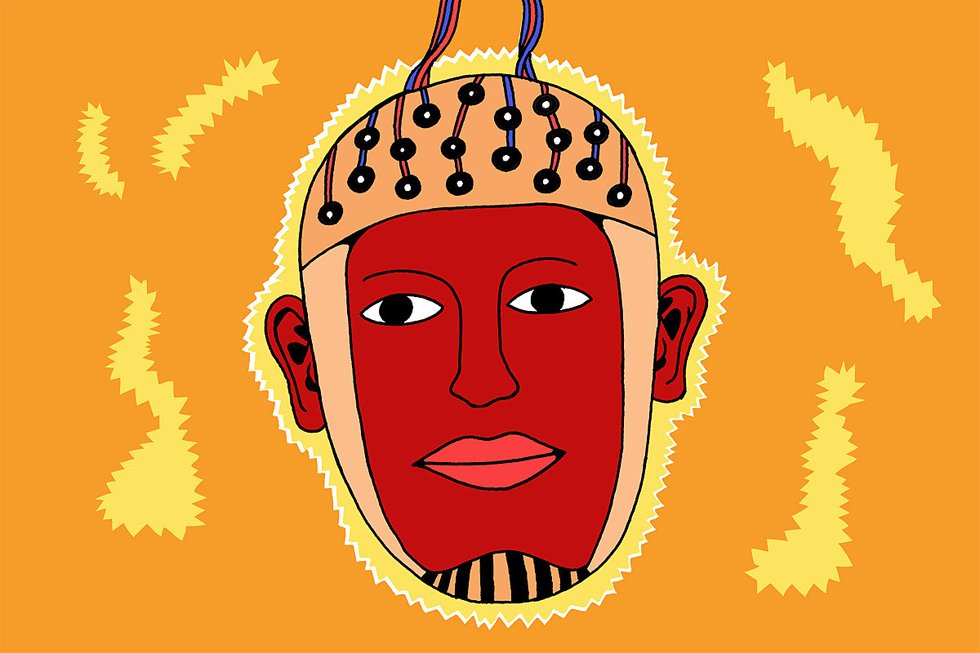Inside out: can neuroscience improve our work lives?
Dec 24, 2019
6 mins

According to a report by Accenture, artificial intelligence could boost worldwide labour productivity by 40% over the next 15 years. Although the latest AI advancements help us to work more productively, they actually have very little impact on our intellectual and emotional acumen. When it comes to understanding signals the brain sends us during the day—for example, about our capabilities, our relationships and reactions to stress—we turn to neuroscience, the study of the brain and the nervous system. Now the business world, in its constant bid to evolve and innovate, has begun to pay attention.
What if neuroscience, instead of artificial intelligence, was the answer to ensuring optimal cooperation between employees—and also increasing wellbeing in the workplace? To answer this question, let’s dive into the obscure world of neuroscience and consider its future impact on our daily work life.
The influence of neuroscience on our daily life
We don’t need to glue electrodes to our temples to understand that neuroscience paves the way for better analysis of how the brain works—whether we are in a meeting, watching a presentation, working in a group, interacting with the boss or just enjoying a coffee break by ourselves.
It’s a goldmine of information about our mental health
According to the historian Yuval Noah Harari, author of Homo Deus: A Brief History of Tomorrow, the search for happiness will be one of three major challenges facing humans in the centuries to come. It will be impossible to overcome this challenge without a profound change in the quality of our work life. It’s an area that neuroscientists are beginning to explore. First and foremost, they have highlighted the importance of having a work environment that corresponds to our cognitive needs—or our need for knowledge—with the aim of making us more efficient. However, regardless of office layout, lighting or how we spend our breaks, there are many other elements that influence our brains and affect our welfare at work.
For example, neuroscience tells us that our brains have limited resources and that our smartphone addiction requires a lot of energy. In fact, it inhibits our ability to engage in activities that could reduce stress. As our connectivity increases, we become more negative, more irritable, and above all, more anxious.
Can neuroscience warn us about health problems?
Neuroscience identifies issues related to our neural functioning, but it can go further than that. It also offers solutions to the tricks our brains play on us, by steering us towards healthier mental health habits. For example, last year Elon Musk boasted about working close to 120 hours per week and being on the edge of a burnout. Arianna Huffington, founder of the Huffington Post and a friend of his, wrote him a letter that stated:
“You’re a science and data-driven person. You’re obsessed with physics, engineering, with figuring out how things work. So apply that same passion for science not just to your products but to yourself. People are not machines. For machines—whether of the First or Fourth Industrial Revolution variety—downtime is a bug; for humans, downtime is a feature.”
Wise words, but they are also backed by neuroscience research on the effects of fatigue on the brain and nervous system. An Italian study published in the Journal of Neuroscience goes a step further by revealing that the brain starts to eat itself after chronic sleep deprivation. In the long term, an efficient employee is no longer the one who stays at the office until midnight, but the one who goes home to relax and switch off before returning to work the next day on top form.
“The brain starts to eat itself after chronic sleep deprivation.”
As well as helping us to feel better, neuroscience also helps us to replace myths with scientific facts. Although it is a popular belief, Dr Marie Lacroix, a sleep and memory specialist and co-founder of Cog’X, explains that learning while we sleep is impossible. In fact, if you go to sleep after studying, it allows your memory to consolidate, which is great news for those who like to nap. After a long morning of training, nothing beats a quick siesta to help transfer information from your short-term to long-term memory.
By adapting the reality of our work to how our brains function, neuroscience could bring welcome insight to management methods and reinforce employee wellbeing.
Moving towards a new management model?
The next generation is searching for meaning and happiness. As they take their first big step into the job market, neuroscience is a firm ally in recruitment and retention in the workplace. To talk about this new approach, companies are even using the term “neuromanagement”.
Emotional intelligence: a new asset for managers
The expression “emotional intelligence” was first used by Professors Peter Salovey and John Mayer in 1990. They view thinking and emotions as not two distinct tools but one that can be separated into three mental processes:
- Perception and expression of emotions
- Control of these emotions
- Evaluation of emotions that determines the cognitive process (how a system processes information by responding to it with an action)
Emotional intelligence is coveted so highly by companies and managers that training on the subject is increasing significantly. Managers who undergo emotional intelligence training learn how to avoid purely reactive attitudes, integrate compassion into their teams, work on attentiveness, give positive and constructive feedback, and become progressive leaders.
A good neuromanager must also have an excellent command of nonverbal communication, both for receiving and sending. In some cases, technology can come to the rescue.
Brain technology
Inevitably, entrepreneurs lose little time in targeting future markets when new discoveries are revealed in a sector.
More and more companies are using fundamental neuroscience research to create new technology that will allow us to become more efficient. This is known as brain technology. Dreem, a French scale-up that developed a headband with sensors capable of monitoring brain behaviour during sleep, is a good example. The purpose of this device is to improve rest through micro-vibrations that transmit pink noise into the inner ear. People who turn to the headband are looking to get more rest and increase mental performance.
Along the same lines, the start-up Melomind has created a stress-relief headset with EEG technology that measures a user’s brain activity. It then plays music corresponding to their state of mind. It uses the neurofeedback principle by taking the results of listening to your brain and then making changes. Up until now, such results could only be obtained by in-depth medical analyses. Today’s advanced, miniaturised technologies make it easier to gather brain information to learn more about ourselves.
The proliferation of light-therapy technology over the past few years in the health and beauty sector is also a result of neuroscience research. Since the dawn of time, humans have governed their lives by sunlight, which fluctuates. Spending our days under fluorescent lighting with the same wattage tends to drain our brains. This is why natural lighting regularly appears as the common denominator in all high-quality work environments.
Watch out for neuro-nonsense
Every year, the American consultancy Gartner publishes its Hype Cycle for Emerging Technologies, an analysis of emerging trends. A sharp eye will notice when looking over the 2018 version that brain-computer interface technology—devices that allow users to control computers through their thoughts, a prosthetic limb or any other automated system—is still at the “Peak of Inflated Expectations” stage. Neurotechnology is a field where research is giving a lot of hope, but has not yet achieved satisfying, concrete results.
According to the experts at Gartner, neurotechnologies will not be widely available for at least another decade. Major research shows promising discoveries on a regular basis, but solid application of the findings is still in the early stages. Nevertheless, its potential has not gone unnoticed. Researchers agree that the possibilities for brain technology are immense. The proof lies in a report by SharpBrains, which shows that more than 1,600 US patents were filed in this category in 2014 compared to 400 in 2010.
At a time when the world is focusing on artificial intelligence to make our daily lives easier, neuroscience might help to establish the complexity of the human brain as a top concern in the workplace. Paradoxically, neuroscience has been able to take a giant leap over the past few years due to advances in neuroimaging (medical imaging techniques used to see the brain). An alchemy between the brain and technology is upending several aspects of daily work life, from the physical workplace to management techniques and teamwork.
Elon Musk (him again) has also shown his allegiance to neuroscience, and cognitive technologies in particular. In 2016, he created Neuralink with the hope of successfully connecting artificial intelligence with the human brain. His goal? To add a digital layer directly to our neurons to increase our mental abilities. Terrifying and exciting in equal measure, this could mark the dawn of a new cerebral era.
Illustration by Pablo Grand Mourcel
Translated by Mary Moritz
Follow Welcome to the Jungle on Facebook and subscribe to our newsletter to receive our best articles.

More inspiration: Mental health

‘We need each other’: Monika Jiang on combating loneliness in hybrid work
Hybrid work offers flexibility but can leave us feeling disconnected. Monika Jiang explores how we can rebuild workplace connections.
Dec 19, 2024

Struggling at work? Here are 3 steps to rebuilding your self-esteem
Low on confidence? Learn how reflection, recharging, and refocusing can help you rebuild self-esteem and thrive professionally.
Nov 27, 2024

10 ways to beat the Sunday Scaries
Even people who love their jobs can experience the Sunday Scaries. Psychologist Karen Doll offers several strategies to help manage and overcome it.
Sep 12, 2024

Unpacking the burden of emotional labor
Rose Hackman’s "Emotional Labor" reveals how managing emotions impacts everyone, especially women and minorities.
Aug 08, 2024

Is financial anxiety harming your productivity?
Feeling overwhelmed by financial anxiety? You're not alone. Discover practical steps and expert advice to regain control of your work-life balance.
Jul 31, 2024
The newsletter that does the job
Want to keep up with the latest articles? Twice a week you can receive stories, jobs, and tips in your inbox.

Looking for your next job?
Over 200,000 people have found a job with Welcome to the Jungle.
Explore jobs
